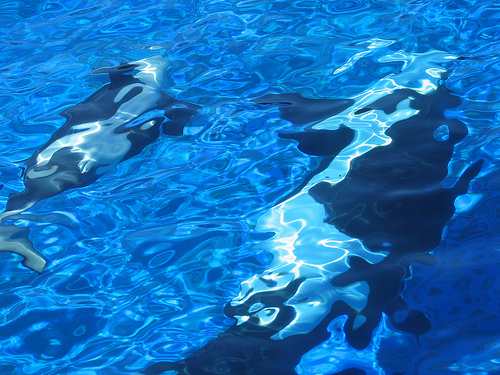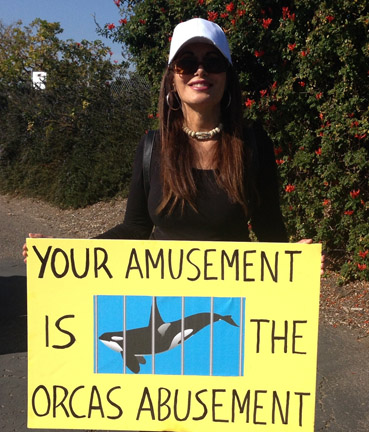This is the second in a series of ten in which we meet one of the San Diego 10 orcas and hear from an advocate who continues to be one of the voices of these imprisoned voiceless, never stopping until the whole world listens.
Prisoner #2: Kasatka
Age: About 36
Captured off the coast of Iceland, on October 26, 1978, Kasatka was just one year old when torn from her pod. Kasatka, whose name comes from the generic Russian derivative of the word “orca,” is 17.7 feet (5.4m) long and weighs 5,950 pounds (2,700 kg.)

Each of Kasatka’s children is captive born. She gave birth to four offspring: Takara, Nakai, Kalia, and Makani. Nakai, born on September 1, 2001, is the first orca to be born as a result of artificial insemination. While his mother, Kasatka, lived in California, his father, Tilikum, was in Florida. Tilikum is featured in the documentary, “Blackfish.” More on Nakai later in this series.
Kasatka’s first child, Takara, was born at Sea World, San Diego on July 9, 1991. Takara’s father is Kotar, like Kasatka, captured in Icelandic waters in 1978 very young, probably less than one year old. He spent his first couple years of captivity at SeaWorld San Diego, moved to SeaWorld Orlando where he bit another male orca’s penis (Kanduke) and was then moved to SeaWorld San Antonio (1988). On April 1, 1995, Kotar died from a fractured skull and severe blood loss caused by a gate closing on his head.
For the first 13 years of Takara’s life, she and Kasatka had a very close bond and spent a lot of time together. In the wild, orcas generally live in close-knit family pods consisting of several females, calves, one or more males and/or juveniles. There are some pods that consist of a mother and her offspring who stay with her for life. Many pods have been documented as stable, consistent matriarchal family groups with several generations traveling together.
Kasatka became a grandmother for the very first time when Takara gave birth to her first calf, a female born on May 3, 2002, named Kohana, the second orca calf bred via artificial insemination, also with Tilikum (who sired Nakai in the same manner with Kasatka). Despite orcas’ natural history of matrilineal pods, Takara was taken away from her mother and moved to Sea World Orlando with her daughter, Kohana, on April 24, 2004 – ten years ago this week.
Takara gave birth a second time, on November 23, 2005, to a male named Trua. Soon thereafter, Takara’s daughter Kohana was taken from her, at less than four years old, and moved to Loro Parque in the Canary Islands in the eastern Atlantic (territory of Spain), where she is one of six orcas on paid loan by SeaWorld.
In February 2009, Takara was also separated from her son, Trua, and moved to SeaWorld San Antonio, where she gave birth in 2010 to a female, Sakari, and most recently in December 2013, to another female, Kamea. At 22 years old, Takara has borne four calves; her mother, Kasatka, has borne four at 35 years old.
Takara’s daughter, Kohana, at 12 has been bred twice since her move to the Canary Islands – the first at just eight years old to a son, Adan, the second at 10 years old to a daughter, Victoria. Kohana rejected both calves, and her daughter died within a year of birth (June 2013).
On December 21, 2004, Kalia (“Beauty” in Hawaiian) was born to Kasatka. Her father is Keet, and she is known as the great grand baby of Shamu. Keet was born at Sea World San Antonio, sired by Kotar who fathered Kalia’s half-sister, Takara. Keet is known as the most heavily transported orca in captive history. This poor orca was separated from his mother at just 18 months. At five years old he was moved to San Diego, where he spent five months before being flown to the now defunct Sea World Ohio. After just one season there he was returned to San Diego. He is 75 percent Icelandic and 25 percent Southern Resident. More on Keet and Kalia later in this series.
Recently, on February 14, 2013, Kasatka gave birth to her fourth calf, a male, conceived via artificial insemination. At birth, Makani (Hawaiian for “Wind”) measured about 6.5 feet and weighed in between 300 and 350 pounds.
Makani’s father is Kshamenk, an Argentinian orca. Kshamenk was wild caught and kept alone in a tank that is far too small for him in Argentina—where he still lives in quiet desperation. Kshamenk (pronounced sha-MEN-k), meaning “orca” in Yamana. Kshamenk is known as “the loneliest orca in the world” and for good reason. He was taken from the wild off the coast of Argentina in 1992. The population he comes from is unknown. He was approximately five years old at the time, making him roughly 26 years old. Initial reports said that Kshamenk, along with three members of his pod, had stranded and been “rescued” by Mundo Marino.
However, it was later revealed that Mundo Marino had “force stranded” the whales by placing a large net between the whales and the shore. When the tide went out, the whales were left stranded on the beach. One was released, one died on the way to the aquarium, one beat himself to death on the walls of his enclosure, and one, Kshamenk, survived.
When Kshamenk arrived at Mundo Marino he was kept with a female orca, “Belen.” They performed in the orca show together for eight years. Kshamenk impregnated Belen in 1998 but the calf was stillborn 16 months later. Belen died shortly after in February 2000, leaving Kshamenk alone. On February 14, 2013, Kshamenk became a father via artificial insemination to Makani, a male calf born to Kasatka at Sea World San Diego, and on December 6, 2013, to a female calf named Kamea, born to Kasatka’s daughter, Takara, at SeaWorld San Antonio on December 6, 2013.
Kshamenk now swims endlessly in circles in a tiny pool designed to fit the size of a bottlenose dolphin, not a full grown male killer whale. The pool that imprisons him is filled with filthy, toxic runoff. In spite of the appeals of over 35 global, anti-captivity organizations for his rehabilitation and release — including Wild Earth Foundation, Humane Society of the United States, Cetacean Society International, and Earth Island Institute—the Secretary of the Environment of Argentina and CITES Argentina denied the request of Mundo Marino to export the whale. (In Argentina it is illegal to export native fauna, and as a wild born orca, Kshamenk is considered part of the commonwealth.) After a veterinary evaluation in 2006, Kshamenk was considered non-releasable.
Kshamenk still lives in his horrific state of solitary confinement at Mundo Marino Argentina and though the efforts to save him still exist, his health is deteriorating. We pray it’s not too late to save him.
Orcas, as we know, are highly sensitive, brilliantly intelligent beings. What happens to one of them literally affects them all in different ways. It is no wonder so many of them have gone mad from such enslavement and cruelty—their anguish and terror passed from generation to generation.
Having known continuous separation and stress since she was a baby it is not a surprise that Kasatka has shown aggression to humans. In 1993 Kasatka tried to bite a trainer during a show, and again in 1999. On November 30, 2006, Kasatka grabbed the same trainer from the 1999 incident, Ken Peters, and dragged him underwater twice during their show. The trainer survived with minor injuries.
Kasatka and her three children with her in San Diego (Nakai, Kalia and Makani) are the least viable San Diego 10 candidates for release into the open ocean to prevent interbreeding in the wild. It would be considered unethical to split Kasatka from her children, and whale conservationists consider it unethical to introduce foreign DNA into a wild ocean pod. The fact is there are several populations of killer whales in the wild with no evidence of interbreeding for thousands of years. The goal would be for captive-bred orcas to be released only into sea pens where they could live out their lives in safe sanctuaries within their own pods.
Kasatka, we are doing all we can to help you…
Prisoner Advocate: Diana Ferrari Parker

Diana was born in Argentina and now lives in Point Loma, in San Diego, ever since she arrived in the United States years ago. As a retired Social Worker, Diana has traveled around the world, speaks more than two languages, and has “…seen the good and the not so good in many countries and cultures.”
When Diana first arrived in San Diego she says:
“I visited different places, one of them was Sea World. I was impressed by the orcas’ beauty and size; though at the same time it shocked and broke my heart that such huge mammals had to live in cement pools. The orcas’ beauty instilled in me a deep passion and interest, causing me to study their life in the wild. Ultimately, it motivated me to become an activist for these magnificent mammals.
“I learned how intelligent and emotional they are, and their unique way of life. In the wild, orcas live in family groups their entire life, and it is believed their family instinct is more developed than human beings. They even have their own sounds and language, allowing distinct communication among individual families.
“It hurts me to think that such magnificent and intelligent mammals are living a captive life in chlorine cement pools with other orcas from unfamiliar families. This causes extreme stress, leading to hostilities between orcas, ending in severe injuries and death not only to the animals but trainers as well. No human has ever been injured or died from an orca in the wild.
“Although Sea World portrays itself as rescuers of marine life, their cruelty to orcas is incomprehensible. True, they rescue many other animals, but just as many are being tormented, filled with despair and enslaved. How can they continue to get away with this? Sea World’s most profitable prisoners are the orcas. The good they do for some does not erase the disgraceful treatment inflicted on the orcas in the name of money. Greed is what drives Sea World, not love!! Captivity does not benefit the wild, and it is NOT educational!!!! Animals deserve respect and fair treatment, they are not objects for our amusement and entertainment. I think Sea World should take the responsibility to retire, rehabilitate and release the orcas and become a responsible organization and continue to thrive in our community.”
Action Items to Help Kshamenk in Argentina
Send an email to the President of Argentina: keiko.com.
Join over 27,000 signatories on a Petition to Mundo Marino.
“We need another and a wiser and perhaps a more mystical concept of animals… In a world older and more complete than ours they move finished and complete, gifted with extensions of the senses we have lost or never attained, living by voices we shall never hear. They are not brethren, they are not underlings; they are other nations, caught with ourselves in the net of life and time, fellow prisoners of the splendour and travail of the earth.”
– Henry Beston
